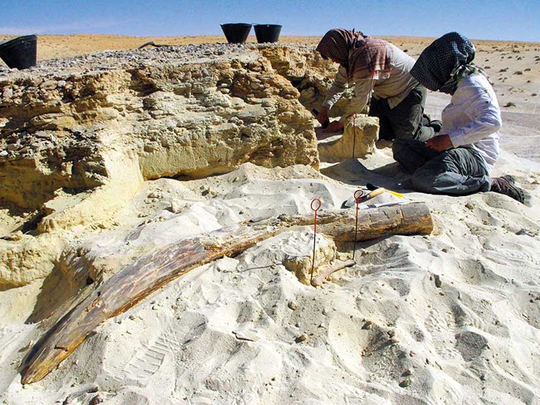
Buried in the Arabian desert’s sand are clues to the peninsula’s wetter, greener past. Fossils from long-extinct elephants, antelope and jaguars paint a prehistoric scene not of a barren wasteland but of a flourishing savannah sprinkled with watering holes.
Now, scientists have found what they think is evidence of the activities of early human relatives, who lived in this ancient landscape some 300,000 to 500,000 years ago. If the findings are confirmed, the stone flakes and butchered animal bones the researchers uncovered would be evidence that early hominins — extinct members of the genus Homo but most likely not of our species — were present in the Arabian Peninsula at least 100,000 years earlier than previously known.
The findings, which were published Monday in the journal Nature Ecology & Evolution, also suggest early hominins did not need any special evolutionary adaptations before they ventured out from the grasslands of Africa and into the wilds of Arabia.
“As the savannah expanded, so did humans of this period,” said Michael Petraglia, an archaeologist from the Max Planck Institute for the Science of Human History in Germany and an author on the paper.
Changing narrative
Petraglia has searched the now-arid desert for evidence of a “Green Arabia” for the past decade. Although the Arabian Peninsula is a key connector between Africa and Eurasia, human migration through it has not been studied as well as in the Levant. And for a while, it was thought the area was too arid for travel by early hominins.
But recent findings are changing that narrative and indicating that the region may have gone through cycles of being dry and being lush. Earlier this year, his team reported finding a nearly 90,000-year-old Homo sapiens finger bone in the desert, and his group has identified traces of about 10,000 ancient, dried-up lakes using satellite imagery.
A few years ago, he and his colleagues recovered fossils of several extinct Arabian mammals from a site in Saudi Arabia’s Nafud Desert. Under a microscope, a rib bone was revealed to have cut marks from a sharp stone tool.
“I don’t think I had realised the gravity of it yet,” said Mathew Stewart, a doctoral student at the University of New South Wales in Sydney. “I didn’t realise this would be the oldest evidence of people in the peninsula to date and that no one had found anything like this before.”
Tracing roots
Along with the marked fossils, the team had found stone flakes, the waste product from stone tool making, at the site. “The stone tools add the nail in the coffin,” said Stewart, providing evidence that hominins had butchered these bones.
The team had also collected more than 20 fossilised teeth at the site from herbivores like antelope, elephants and ancient horses. Patrick Roberts, an archaeological scientist also from the Max Planck Institute for the Science of Human History and lead author on the study, analysed the enamel of the teeth for carbon and oxygen isotope data.
For a while, it was thought the area was too arid for travel by early hominins. But recent findings are indicating that the region may have gone through cycles of being dry and being lush.
Tooth enamel grows incrementally, similar to tree rings, so it gives insight into changes over a period of time. The carbon isotope signatures provided data about the herbivores’ diets. The oxygen isotope reflects the source water for precipitation, humidity levels and temperature.
Roberts’ analysis showed that the mammals had a diet of plants found in grasslands, suggesting that rainfall where they lived occurred during the warm season. And the oxygen isotopes indicated that conditions were much wetter in the region then.
Right now, the team says the site’s fossils could be as much as 500,000 years old. Because the earliest known evidence of Homo sapiens dates to about 300,000 years ago in Morocco, the scientists do not think that the hominin that made these marks was Homo sapiens. That means that the early hominins who travelled out of Africa through Arabia did not need to be biologically equipped to face a harsher environment than the one they were leaving.
“These hominins were encountering things in Arabia that were quite similar to what we think of in the East African savannah today,” Roberts said. “They aren’t dispersing into a desert; we argue it’s just part of a range expansion.”












